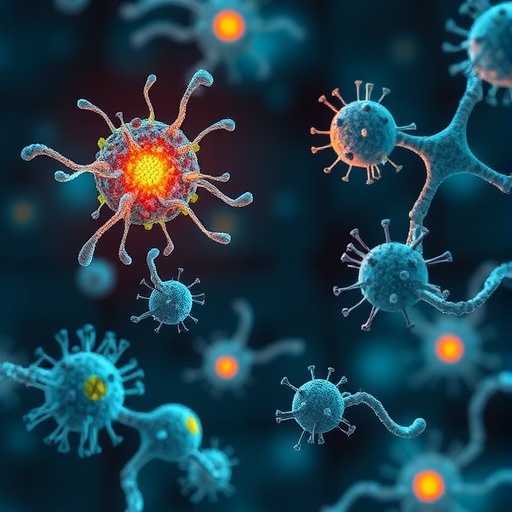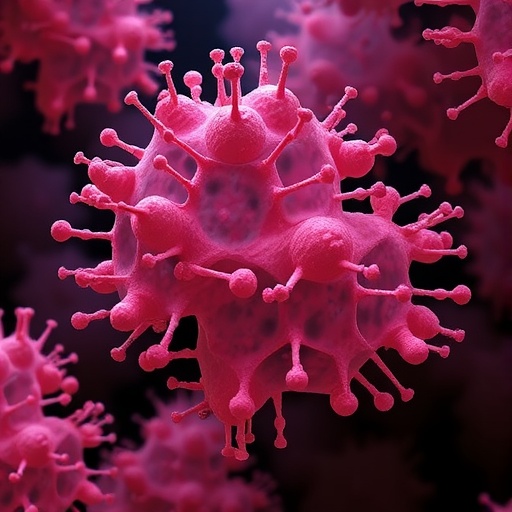In a groundbreaking revelation that could redefine our understanding of bacterial defense mechanisms, researchers have unveiled the intricate workings of a novel prokaryotic Argonaute system known as SPARDA. This system, discovered in bacteria such as Xanthobacter autotrophicus and Enhydrobacter aerosaccus, presents a fascinating strategy against foreign DNA invasions, utilizing a distinctive structural and biochemical response to neutralize threats effectively. Unlike the well-studied eukaryotic Argonautes, which mainly regulate RNA silencing pathways, SPARDA operates by deploying a lethal DNA degradation response triggered upon detection of invasive genetic elements.
The study delves into the molecular choreography of SPARDA, detailing how this defense apparatus employs short DNA oligonucleotide guides to recognize and target complementary DNA sequences. This mode of action not only allows specific identification of invading plasmid DNA but also initiates a catastrophic self-destructive program within the host bacterium—ultimately leading to cell death. Such suicidal defense acts as a population-level barrier to the spread of plasmids, underpinning a form of altruism among bacterial communities to preserve overall population integrity against persistent threats.
One of the most striking features uncovered is the structural basis of SPARDA’s activation mechanism. Using cutting-edge X-ray crystallography, researchers have shown that in its resting, or apo, state, SPARDA adopts a dimeric configuration, a stark contrast to other short prokaryotic Argonautes, which are typically monomeric when unbound. This dimerization is not a mere static form but serves a critical inhibitory role, maintaining the SPARDA complex in an inactive conformation to prevent unwarranted DNA degradation under normal cellular conditions.
Activation of SPARDA induces a remarkable conformational transformation where the inhibitory dimer architecture dissociates into monomeric units upon binding of the guide-target DNA duplex. This transition is far from trivial; the released monomers subsequently polymerize into extensive filamentous assemblies. Cryo-electron microscopy has been pivotal in capturing these dynamic filament formations, providing unparalleled insights into the supramolecular organization of activated SPARDA complexes.
Central to the signaling cascade that triggers filament assembly is a newly characterized structural motif termed the “beta-relay.” This motif facilitates the communication of conformational changes originating from the guide-target recognition site to distant functional domains within the protein, enabling coordinated activation of the DNA cleavage machinery. The beta-relay emerges as a critical molecular conduit, orchestrating the allosteric relay of the recognition event across the protein complex—a feature that appears to be conserved across various clades of prokaryotic Argonautes.
Within the filamentous assemblies, the DREN nuclease domains—responsible for DNA cleavage—come together to form tetramers precisely positioned to execute efficient double-stranded DNA cleavage activity. This spatial organization likely enhances the nuclease activity and substrate accessibility, ensuring a robust and irreversible degradation of both invading and host chromosomal DNA. Such an aggressive defense strategy underlines the extraordinary evolutionary pressure on bacteria to curtail the horizontal transfer of plasmids and other mobile genetic elements that can compromise genome integrity.
Beyond the specific bacterial systems of Xanthobacter and Enhydrobacter, the researchers have extended their observations to demonstrate that filament formation is a common theme in the activation of other SPARDA homologs. This conservation underscores the evolutionary advantage conferred by filamentation and the beta-relay signaling mechanism, suggesting a universal strategy employed by diverse prokaryotic Argonautes to achieve rapid and decisive immune responses.
The structural and functional insights provided by this work highlight the nuanced balance between self-preservation and self-sacrifice within bacterial populations. By sacrificing individual cells via DNA degradation-induced death, the broader community is shielded from plasmid proliferation—a classical example of programmed cell death applied at the microbial scale. These findings also raise important questions about the regulation of such potent defense systems, as uncontrolled activation would be deleterious to the host.
Mechanistically, the stepwise transition from dimer to monomer and ultimately to filament represents a dynamic allosteric process finely tuned to ensure minimal wastage of cellular resources while maximizing defensive efficacy. The beta-relay motif’s discovery opens new avenues for understanding cross-domain communication within proteins and could inspire biomimetic designs for synthetic biology applications aiming to engineer controllable nucleic acid targeting systems.
Moreover, the data provide a compelling framework for future investigations into the diversity of Argonaute-mediated defense strategies across the prokaryotic domain. Considering that Argonaute proteins are broadly distributed and functionally versatile, the elucidation of SPARDA activation enriches the molecular lexicon governing nucleic acid-interacting protein complexes and might reveal targets for novel antimicrobial interventions by manipulating bacterial immune systems.
From a biotechnological perspective, the ability of SPARDA to assemble into filaments upon guide/target recognition and to execute programmable DNA cleavage with high specificity holds promise for applications in genome editing and synthetic microbial population control. Harnessing the beta-relay signaling pathway could allow creation of switchable nucleases with tunable activity, carrying significant implications for gene therapy and biosafety containment strategies.
This discovery also lays the foundation for understanding bacterial altruistic suicide based on targeted nucleic acid degradation—concepts relevant not only to microbiology but also to evolutionary biology and ecology. The integration of structural biology directly with functional assays exemplifies how multidisciplinary approaches can unravel complex molecular machines beyond traditional enzymology paradigms.
In summary, the characterization of SPARDA systems from Xanthobacter autotrophicus and Enhydrobacter aerosaccus reveals an elegant defense mechanism grounded in protein conformational plasticity, higher-order filament formation, and beta-relay signaling. These findings profoundly expand our understanding of prokaryotic Argonaute systems and highlight innovative molecular strategies bacteria employ to secure genomic stability and population survival. The insights gained herein promise to catalyze further research into the structural biology of nucleic acid-guided immunity and the development of next-generation molecular tools inspired by nature’s intricate designs.
Subject of Research: Prokaryotic Argonaute (pAgo) proteins and bacterial defense mechanisms involving SPARDA systems.
Article Title: Activation of the SPARDA defense system by filament assembly using a beta-relay signaling mechanism widespread in prokaryotic Argonautes.
Article References:
Jurgelaitis, E., Zagorskaitė, E., Kopūstas, A. et al. Activation of the SPARDA defense system by filament assembly using a beta-relay signaling mechanism widespread in prokaryotic Argonautes. Cell Res (2025). https://doi.org/10.1038/s41422-025-01198-1
Image Credits: AI Generated
DOI: https://doi.org/10.1038/s41422-025-01198-1
Tags: altruism in bacterial communitiesbacterial defense mechanismsDNA degradation responseEnhydrobacter aerosaccusforeign DNA invasionsmolecular choreography of SPARDAplasmid DNA targetingprokaryotic Argonaute systemSPARDA activation mechanismsuicidal defense in bacteriaX-ray crystallography in microbiologyXanthobacter autotrophicus





